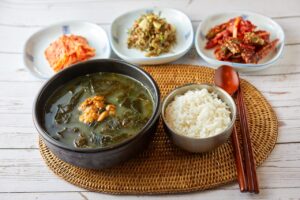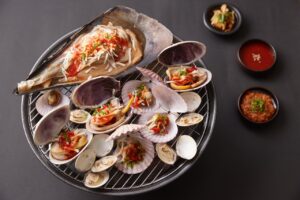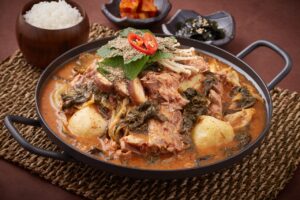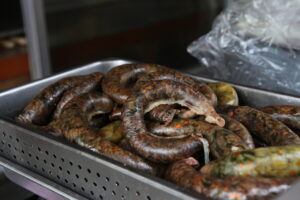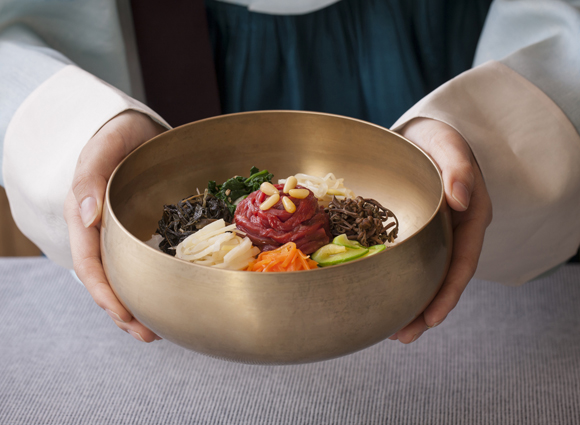
Bibimbap: A Delicious Journey Through Korean Cuisine
Introduction:
Bibimbap (비빔밥), a vibrant and flavorful Korean dish, has become a global sensation, captivating taste buds and hearts worldwide. This iconic Korean creation showcases a harmonious blend of colors, textures, and flavors that come together in a single bowl. In this article, we’ll take you on a culinary journey through the world of Bibimbap, exploring its origins, ingredients, variations, and the art of savoring this delightful dish.
Unveiling the Beauty of Bibimbap:
1. Origins :
Bibimbap traces its roots to Korea, where it has been a beloved dish for centuries. The name “Bibimbap” translates to “mixed rice,” reflecting its preparation method of mixing various ingredients with a bed of steamed rice. Its history is steeped in Korean culture, appearing in ancient royal court cuisine and as a cherished homemade meal.
2. The Art of Mixing:
At the heart of Bibimbap lies the art of mixing. A typical it’s bowl features a colorful array of vegetables, such as carrots, cucumbers, spinach, bean sprouts, and mushrooms. These veggies are often accompanied by protein sources like bulgogi (marinated beef), tofu, or a fried egg. The final flourish is a dollop of gochujang, a spicy and savory red pepper paste that infuses the dish with a bold kick.
3. Regional Variations:
Korea’s diverse culinary landscape has given rise to regional variations of Bibimbap. Jeonju Bibimbap, for instance, hails from the city of Jeonju and is known for its artful presentation and high-quality ingredients. Similarly, Dolsot Bibimbap is served in a sizzling hot stone bowl, creating a crispy layer of rice at the bottom.
4. A Wholesome and Nutritious Feast:
It isn’t just a treat for the taste buds; it’s a nutritious powerhouse. Packed with an abundance of vegetables, lean proteins, and rice, it provides a balanced meal that’s as satisfying as it is healthy. The diverse range of ingredients ensures that each bite is a burst of flavor and nutrition.
5. Bibimbap Beyond Borders:
In recent years, it’s popularity has transcended borders, captivating international palates. Korean restaurants around the world now serve their take on this delectable dish, introducing it to a global audience eager to explore Korean cuisine.
Savoring the Experience:
Part of the joy of Bibimbap is the experience of mixing and customizing your bowl to your taste. The vibrant colors and contrasting textures make it a visually appealing dish, and the combination of flavors offers a delightful sensory journey. Whether you’re enjoying it at a Korean restaurant, trying it at home, or exploring regional variations, Bibimbap invites you to embrace its artful chaos.
Conclusion:
This is more than a dish; it’s a celebration of diversity and harmony on a plate. With its roots in Korean tradition and its global appeal, it’s a testament to the power of food to connect cultures and create moments of culinary bliss. So, the next time you’re in the mood for a flavorful adventure, consider embarking on a special journey, and savor every delightful bite.
Bibimbap Festival, Jeonju City.
The Bibimbap Festival in Korea is a vibrant celebration of one of Korea’s most beloved dishes, Bibimbap. This annual event typically takes place in various regions across South Korea, with different cities and towns hosting their own unique versions of the festival.
The Festival offers a wonderful opportunity for locals and tourists alike to come together and celebrate Korean culture and cuisine. Here are some key features and activities commonly found at the Festivals:
- Tasting: Visitors can sample a wide variety of Bibimbap dishes prepared by local restaurants and vendors. These often showcase regional ingredients and flavors, allowing attendees to explore different regional variations of the dish.
- Cooking Demonstrations: Renowned chefs and culinary experts often conduct live cooking demonstrations, sharing tips and techniques for making the perfect one.
- Making Contests: Participants, both amateur and professional, can join Bibimbap-making contests to showcase their culinary skills. Judges evaluate entries based on taste, presentation, and creativity.
- Food Stalls and Vendors: Beyond Bibimbap, festival-goers can enjoy a wide range of Korean street food and snacks, adding to the culinary adventure.
- Cultural Performances: The festivals often feature traditional Korean performances, including music, dance, and martial arts displays, providing a rich cultural experience.
- Art and Craft Exhibitions: Visitors can explore art and craft exhibitions, often showcasing traditional Korean handicrafts and artwork.
- Local Produce and Crafts: Many Festivals also include marketplaces where local artisans and farmers sell their products, making it a great opportunity to purchase unique souvenirs and regional specialties.
- Interactive Workshops: Festival-goers can participate in various workshops, such as making kimchi or traditional Korean crafts, allowing for hands-on experiences.
- Food Challenges: Some festivals even offer food challenges where participants attempt to consume massive bowls of Bibimbap within a certain time limit.
- Cultural Exchange: The festivals often attract international visitors, promoting cultural exchange and showcasing Korean cuisine to the world.
The Bibimbap Festival is a lively and colorful celebration that brings people together to enjoy the diverse and delicious world of Bibimbap. If you have the opportunity to visit South Korea during one of these festivals, it’s a fantastic way to immerse yourself in Korean culture and savor the flavors of this iconic dish.
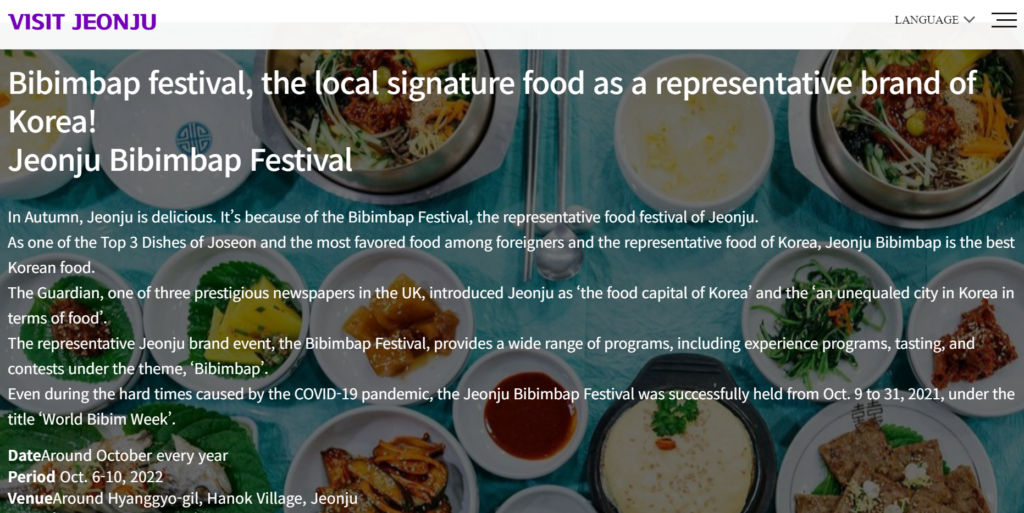
Cooking Method
Ingredients:
For the Bibimbap bowl:
- 2 cups of cooked short-grain white rice (preferably Korean or sushi rice)
- Assorted vegetables (e.g., carrots, spinach, bean sprouts, cucumber, zucchini, and mushrooms)
- Protein of your choice (e.g., bulgogi, tofu, or a fried egg)
- Gochujang (Korean red pepper paste)
- Sesame oil
- Soy sauce
- Sugar
- Salt
- Toasted sesame seeds
- Vegetable oil (for sautéing)
Instructions:
1. Prepare the Vegetables:
- Julienne or thinly slice the vegetables. You can blanch or sauté them lightly for a few minutes to soften and season them.
2. Prepare the Protein:
- If you’re using bulgogi or any other protein, cook it according to your preferred method. Bulgogi is often marinated in a mixture of soy sauce, sugar, sesame oil, garlic, and ginger, then stir-fried.
3. Make Gochujang Sauce:
- In a small bowl, combine 2 tablespoons of gochujang (Korean red pepper paste), 1 tablespoon of sugar, 1 tablespoon of soy sauce, and 1 tablespoon of sesame oil. Adjust the quantities to achieve your desired level of spiciness and sweetness.
4. Assemble the Bibimbap:
- Start with a bowl of cooked rice as the base.
- Arrange the assorted vegetables and protein on top of the rice in a visually appealing manner. Traditionally, each ingredient is placed in its own section around the bowl, creating a colorful and organized presentation.
- Optionally, add a sunny-side-up fried egg on top.
5. Drizzle with Sesame Oil:
- Generously drizzle the Bibimbap with toasted sesame oil. This not only adds flavor but also enhances the dish’s aroma.
6. Add Gochujang Sauce:
- Spoon the gochujang sauce over the ingredients. The gochujang will provide a spicy and savory kick to your Bibimbap.
7. Garnish with Sesame Seeds:
- Sprinkle toasted sesame seeds over the top for added texture and nuttiness.
8. Mix and Enjoy:
- Bibimbap means “mixed rice” in Korean, so it’s time to mix everything together. Use a spoon or chopsticks to thoroughly combine the rice, vegetables, protein, gochujang sauce, and sesame oil. Mixing is not just a practical step; it’s part of the Bibimbap experience!
9. Taste and Adjust:
- Taste your Bibimbap and adjust the flavors as needed. You can add more gochujang sauce, sesame oil, or soy sauce to suit your palate.
10. Serve and Enjoy:
- Transfer your beautifully mixed Bibimbap to a plate or bowl and savor every bite of this delightful Korean dish.
Bibimbap is not only a delicious meal but also an artful one. Feel free to get creative with your ingredient choices and presentation. This versatile dish allows you to customize it to your liking, making it a delightful culinary adventure in your own kitchen.

